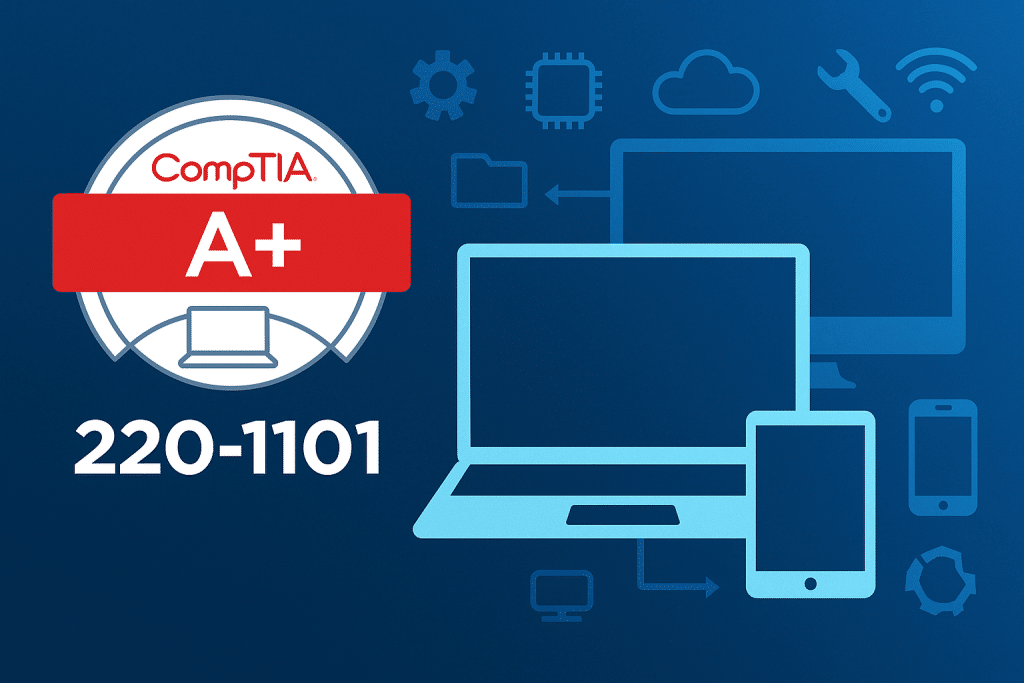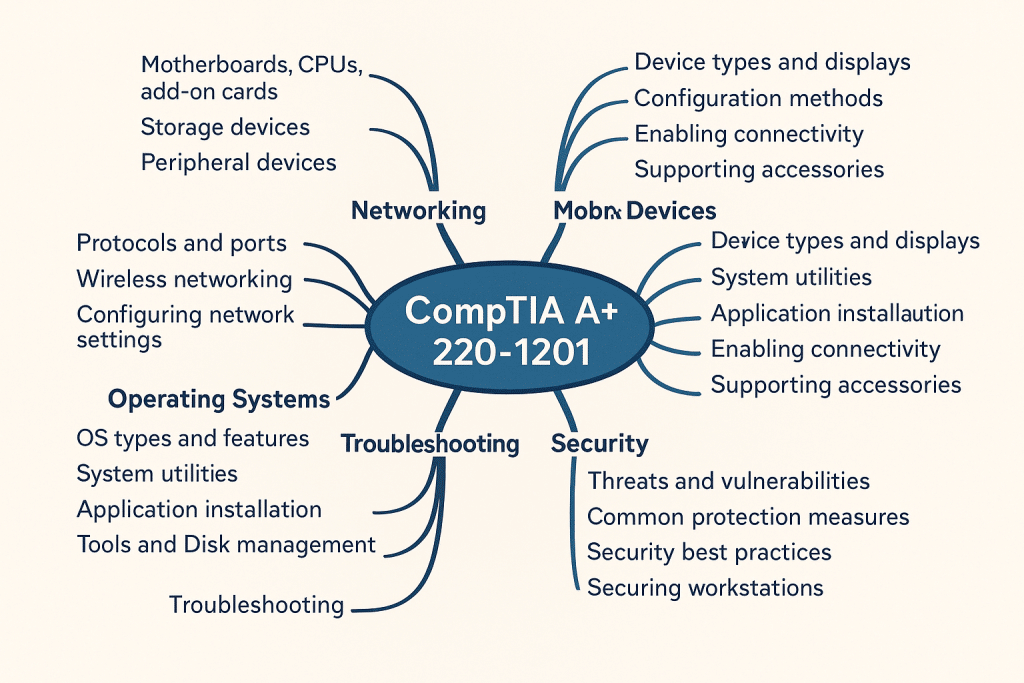
What is the CompTIA A+ 220-1201 Exam?
The CompTIA A+ 220-1201 exam is the first of two exams required to earn the CompTIA A+ Core Series (220-1201 & 220-1202) certification. It is an entry-level IT certification exam that validates a candidate’s knowledge of hardware, networking, mobile devices, and troubleshooting skills. CompTIA A+ is widely recognized as the industry standard for starting a career in IT support and help desk roles.
Unlike general IT courses, A+ is vendor-neutral, meaning it covers technologies from multiple providers (Microsoft, Apple, Linux, networking vendors, etc.), preparing candidates to work in diverse IT environments.
Who should take the CompTIA A+ 220-1201 exam?
The CompTIA A+ 220-1201 is designed for beginners in IT who want to establish a foundation in hardware, networking, and troubleshooting.
Typical candidates include:
- Aspiring IT professionals with little or no formal experience.
- Help desk technicians looking to validate skills.
- PC support specialists who handle installation and maintenance.
- Field service technicians who repair and configure end-user devices.
- Students and career changers aiming to enter the IT industry.
Experience level: Generally suited for candidates with 9–12 months of hands-on or lab experience, but many entry-level candidates start with A+ as their very first certification.
Prerequisites and recommendations
Official prerequisites: None. Anyone can register for the exam.
CompTIA’s recommendation: At least 9–12 months of IT support experience, or equivalent hands-on practice in a lab environment.
Practical recommendations:
- Completing CompTIA IT Fundamentals (ITF+) first, if you are brand new to IT.
- Familiarity with basic computer hardware (motherboards, RAM, storage).
- Understanding of operating systems like Windows, macOS, and Linux.
- Comfort with networking basics (IP addresses, routers, switches).
Exam objectives and domains
The CompTIA A+ 220-1201 exam is divided into weighted domains:
- Mobile Devices – 15%
- Networking – 20%
- Hardware – 25%
- Virtualization and Cloud Computing – 11%
- Hardware and Network Troubleshooting – 29%

Objective details by domain
Mobile Devices (15%)
- Install and configure laptop hardware and components.
- Compare and contrast features of mobile devices.
- Set up mobile device accessories (keyboards, docking stations).
- Configure mobile device network connectivity and synchronization.
Networking (20%)
- Compare common networking hardware (routers, switches, access points).
- Understand TCP/IP protocols and addressing.
- Install and configure SOHO (small office/home office) networks.
- Compare wireless networking standards and encryption methods.
- Troubleshoot basic wired and wireless connections.
Hardware (25%)
- Identify types of cables, connectors, and storage devices.
- Explain motherboard, RAM, CPU, and power supply characteristics.
- Install and configure printers and peripherals.
- Understand expansion cards, BIOS/UEFI, and cooling methods.
Virtualization and Cloud Computing (11%)
- Compare and contrast cloud models (IaaS, SaaS, PaaS).
- Set up and configure client-side virtualization.
- Understand the role of virtualization in modern IT.
Hardware and Network Troubleshooting (29%)
- Resolve wired/wireless connectivity issues
- Apply the troubleshooting methodology (identify, test, verify, document).
- Diagnose hardware issues (motherboard, RAM, CPU, power).
- Troubleshoot storage and display issues.
- Diagnose printer and mobile device problems.
What changed in this version
CompTIA refreshes A+ every 3 years to keep it relevant. Key updates in CompTIA A+ 220-1201 include:
- Shift in weighting; troubleshooting now carries the heaviest domain percentage (29%).
- More emphasis on virtualization and cloud computing.
- Updated networking objectives with Wi-Fi 6 and modern security protocols.
- Streamlined mobile device topics to reflect current devices.
- Greater focus on troubleshooting methodologies across hardware and networks.
- Removal of legacy technologies (older connectors, outdated wireless standards).
Registration and scheduling
- Register through Pearson VUE (CompTIA’s testing partner).
- Choose in-person at a test center or online proctored exam.
- Exams are available year-round, scheduled by appointment.
- Candidates need a valid CompTIA account to schedule.
Pricing and vouchers
Standard exam cost (U.S.): $246 USD per exam.
Regional pricing: Varies by country; often lower in developing regions.
Discounts:
- Bulk voucher purchases for training centers or employers.
- Student discounts through CompTIA Academic Store.
- Military and veteran discounts (via DoD 8570 programs in the U.S.).
Policies you should know
- Retake policy:
- Fail once → retake allowed immediately.
- Fail twice → 14-day waiting period.
- Expiration: Vouchers typically valid for 12 months from purchase.
- Name matching: Name on exam must match official ID.
- Reschedule/Cancellation: Allowed up to 24 hours before appointment.
Scoring and results
- Scoring scale: 100–900.
- Passing score (220-1201): 675.
- Question types: Multiple choice (single & multiple response), performance-based, drag-and-drop.
- Partial credit: Not officially disclosed, but some performance-based questions may award it.
- Result delivery: Immediate pass/fail at exam end.
- Score report: Provided with domain-by-domain performance breakdown.
Exam day and test experience
- On-site testing: Bring two forms of ID; lockers for personal items.
- Online proctoring: Webcam and microphone required; quiet room; room scan before start.
- Allowed items: None, no notes, phones, or watches.
- Breaks: No scheduled breaks; timer runs continuously.
- Interface tips: Flag questions for review; don’t spend too long on one question.
- Time management:
- Spend ~1 minute per question, flag tough ones, and return later.
- 90 minutes for 90 questions.
Study plan and resources
Beginner (8–10 weeks plan):
- Weeks 1–2: Study exam objectives, cover hardware basics, build a PC virtually or physically.
- Weeks 3–4: Deep dive into networking, IP addressing, and SOHO setups.
- Weeks 5–6: Learn mobile devices and virtualization concepts.
- Weeks 7–8: Practice troubleshooting labs, watch CompTIA training videos.
- Week 9: Take full-length practice exams, review weak domains.
- Week 10: Final revision, exam readiness check.
Experienced IT candidates (4–6 weeks plan):
- Weeks 1–2: Skim domains, focus on virtualization/cloud updates.
- Weeks 3–4: Take practice exams; reinforce weak areas.
- Weeks 5–6: Review official study guide, exam cram sessions, and attempt exam.
Recommended resources:
- Hands-on labs with old PCs, routers, or virtualization software.
- CompTIA CertMaster Learn + Labs.
- Professor Messer’s free YouTube A+ series.
- Practice tests from ExamCompass or MeasureUp.
Certification validity and renewal
Validity: 3 years from the date of certification.
Renewal options:
- Complete the CompTIA CertMaster CE renewal course.
- Earn Continuing Education Units (CEUs) through training, webinars, or other certifications.
- Pass a higher-level CompTIA exam (e.g., Network+, Security+).
Career outcomes after CompTIA A+ 220-1201 Exam
Job titles after A+:
- Associate Network Engineer
- Help Desk Technician
- Desktop Support Specialist
- IT Support Specialist
- Field Service Technician
| Job Role | Typical Responsibilities | Average Salary (U.S.) | Salary Range (Entry–Experienced) |
|---|---|---|---|
| Help Desk Technician | Provide first-level support, resolve user issues, escalate complex problems. | $45,000 | $35,000 – $52,000 |
| Desktop Support Specialist | Install, configure, and troubleshoot desktops, laptops, and peripherals. | $50,000 | $40,000 – $60,000 |
| IT Support Specialist | General IT support across hardware, software, and networking in business environments. | $55,000 | $42,000 – $65,000 |
| Field Service Technician | On-site troubleshooting, hardware replacement, and network/device installations. | $53,000 | $40,000 – $62,000 |
| Associate Network Engineer | Assist in managing switches, routers, and small networks; support connectivity issues. | $60,000 | $48,000 – $70,000 |
| Technical Support Specialist | Provide advanced troubleshooting for software, networks, and end-user systems. | $58,000 | $45,000 – $68,000 |
| Junior Systems Administrator | Monitor and maintain servers, patch updates, and handle basic system administration tasks. | $62,000 | $50,000 – $72,000 |
Related or next-step certifications
After CompTIA A+, candidates often pursue:
- Cisco CCNA – for advanced networking roles.
- CompTIA Network+ – to specialize in networking.
- CompTIA Security+ – to enter cybersecurity.
- Microsoft Certified: Azure Fundamentals – for cloud exposure.
How this exam compares to similar certifications
- vs Microsoft Fundamentals (AZ-900): A+ is broader, hands-on, covers hardware + networking; AZ-900 is more cloud-focused.
- vs Cisco CCNA: A+ is entry-level across IT domains; CCNA is specialized and more advanced, usually taken after A+.
Ready to ace your CompTIA A+ 220-1201 exam? The right preparation makes all the difference. Start by practicing with 220-1201 exam dumps from CertEmpire, designed to match the real exam format and boost your confidence. You can also test your knowledge with their free 220-1101 Core 1 practice exam to see where you stand before exam day. Take the smart step today and prepare with resources trusted by thousands of successful IT professionals.
Frequently Asked Questions (FAQs)
Is CompTIA A+ 220-1201 enough to get a job?
Yes. Many employers accept A+ as the minimum requirement for entry-level IT roles like help desk and desktop support. However, pairing it with experience or further certifications (Network+/Security+) increases job opportunities.
How many exams do I need to pass for CompTIA A+ 220-1201?
You must pass two exams: 220-1201 (hardware/networking) and 220-1202 (software/operating systems).
How long should I study for CompTIA A+ 220-1201?
Beginners usually need 8–10 weeks, while experienced candidates may only need 4–6 weeks with practice exams and labs.
Can I take the CompTIA A+ 220-1201 exam online?
Yes. CompTIA offers both test center exams and online proctored exams that can be taken from home with a webcam and stable internet.


